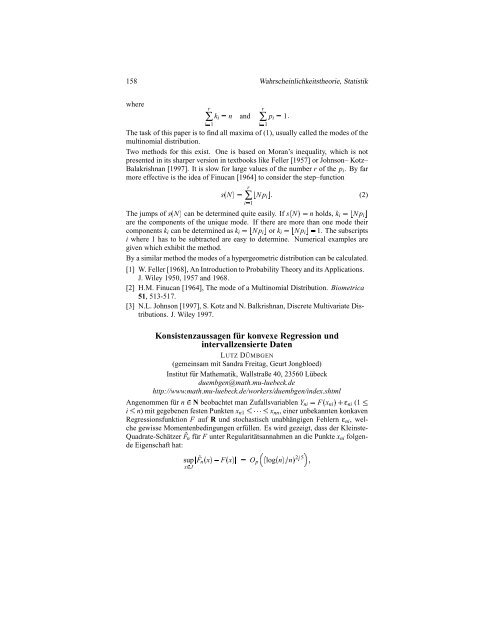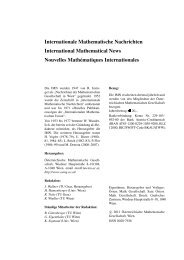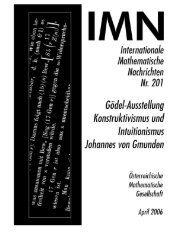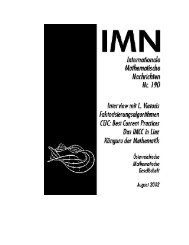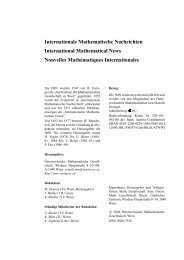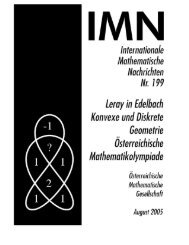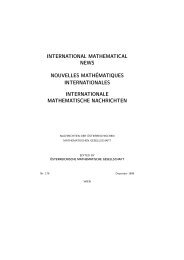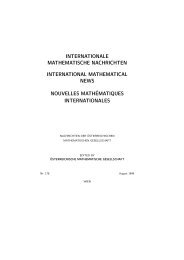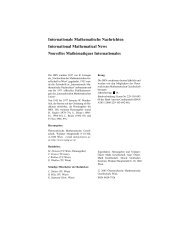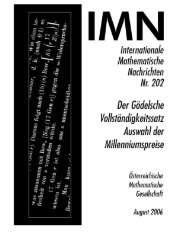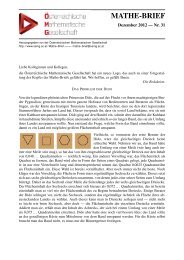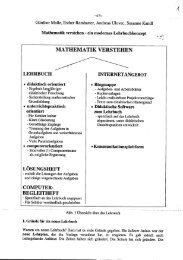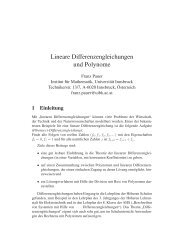Redaktion: K. Sigmund, G. Greschonig (Univ. Wien, Strudlhofgasse ...
Redaktion: K. Sigmund, G. Greschonig (Univ. Wien, Strudlhofgasse ...
Redaktion: K. Sigmund, G. Greschonig (Univ. Wien, Strudlhofgasse ...
Erfolgreiche ePaper selbst erstellen
Machen Sie aus Ihren PDF Publikationen ein blätterbares Flipbook mit unserer einzigartigen Google optimierten e-Paper Software.
158 Wahrscheinlichkeitstheorie, Statistik<br />
where<br />
r<br />
∑<br />
1 i�<br />
ki � n and<br />
r<br />
∑ pi � 1�<br />
1 i�<br />
The task of this paper is to find all maxima of (1), usually called the modes of the<br />
multinomial distribution.<br />
Two methods for this exist. One is based on Moran’s inequality, which is not<br />
presented in its sharper version in textbooks like Feller [1957] or Johnson– Kotz–<br />
Balakrishnan [1997]. It is slow for large values of the number r of the pi. By far<br />
more effective is the idea of Finucan [1964] to consider the step–function<br />
s� N���<br />
r<br />
∑<br />
1¨ i� N pi© �<br />
The jumps of s� N� can be determined quite easily. If s� N��� n holds, ki �<br />
N pi©<br />
are the components of the unique mode. If there are more than one mode their ¨<br />
components ki can be determined as � ki<br />
¨ N pi© or � ki<br />
¨ N pi© 1. The subscripts<br />
�<br />
i where 1 has to be subtracted are easy to determine. Numerical examples are<br />
given which exhibit the method.<br />
By a similar method the modes of a hypergeometric distribution can be calculated.<br />
[1] W. Feller [1968], An Introduction to Probability Theory and its Applications.<br />
J. Wiley 1950, 1957 and 1968.<br />
[2] H.M. Finucan [1964], The mode of a Multinomial Distribution. Biometrica<br />
51, 513-517.<br />
[3] N.L. Johnson [1997], S. Kotz and N. Balkrishnan, Discrete Multivariate Distributions.<br />
J. Wiley 1997.<br />
Konsistenzaussagen für konvexe Regression und<br />
intervallzensierte Daten<br />
LUTZ DÜMBGEN<br />
(gemeinsam mit Sandra Freitag, Geurt Jongbloed)<br />
Institut für Mathematik, Wallstraße 40, 23560 Lübeck<br />
duembgen@math.mu-luebeck.de<br />
http://www.math.mu-luebeck.de/workers/duembgen/index.shtml<br />
Angenommen für � n N beobachtet man Zufallsvariablen � Yni � xni� � F εni � (1<br />
� i n) mit gegebenen festen Punkten � ����� � xn1 xnn, einer unbekannten konkaven<br />
Regressionsfunktion F auf R und stochastisch unabhängigen Fehlern εni, welche<br />
gewisse Momentenbedingungen erfüllen. Es wird gezeigt, dass der Kleinste-<br />
Quadrate-Schätzer ˆFn für F unter Regularitätsannahmen an die Punkte xni folgende<br />
Eigenschaft hat:<br />
sup<br />
x� J � ˆFn� x� � F� x� � � Op � � log� n��� n� 2� 5� �<br />
(2)


